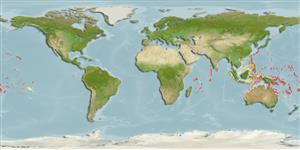Actinopterygii (ray-finned fishes) >
Perciformes (Perch-likes) >
Acanthuridae (Surgeonfishes, tangs, unicornfishes) > Acanthurinae
Etymology: Acanthurus: Greek, akantha = thorn + Greek, oura = tail (Ref. 45335). More on author: Forster.
Environment / Climate / Range
Ecology
Marine; reef-associated; depth range 0 - 8 m (Ref. 89972). Tropical, preferred ?; 30°N - 30°S, 52°E - 140°W
Indo-Pacific: oceanic islands in the western Indian Ocean to the Hawaiian, Marquesan and Tuamoto islands, north to the Ryukyu Islands, south to New Caledonia and Rapa.
Size / Weight / Age
Maturity: Lm ? range ? - ? cm
Max length : 26.0 cm TL male/unsexed; (Ref. 9710)
Dorsal
spines
(total): 9;
Dorsal
soft rays
(total): 27-30;
Anal
spines: 3;
Anal
soft rays: 23 - 26. Preserved color is brown; spotted, white spots usually bordered with dark brown (may help conceal it in turbulent water that is often filled with small bubbles). Pelvic fins bright yellow. Each side of caudal peduncle with a single, sharp, forward-pointing erectile spine. Gill rakers on anterior row: 21-24; gill rakers on posterior row: 19-23.
Occurs in surge zone of clear seaward reefs (Ref. 9710, 58302). Benthopelagic (Ref. 58302); mainly oceanic and found schooling in shallow depths over reef flats subject to surge or currents (Ref. 48637). Browses on filamentous and calcareous algae. Forms schools.
Life cycle and mating behavior
Maturity | Reproduction | Spawning | Eggs | Fecundity | Larvae
Randall, J.E., 1956. A revision of the surgeonfish genus Acanthurus. Pac. Sci. 10(2):159-235. (Ref. 1920)
IUCN Red List Status (Ref. 115185)
CITES (Ref. 94142)
Not Evaluated
Threat to humans
Harmless
Human uses
Fisheries: commercial; aquarium: commercial
More information
Common namesSynonymsMetabolismPredatorsEcotoxicologyReproductionMaturitySpawningFecundityEggsEgg development
ReferencesAquacultureAquaculture profileStrainsGeneticsAllele frequenciesHeritabilityDiseasesProcessingMass conversion
Tools
Special reports
Download XML
Internet sources
